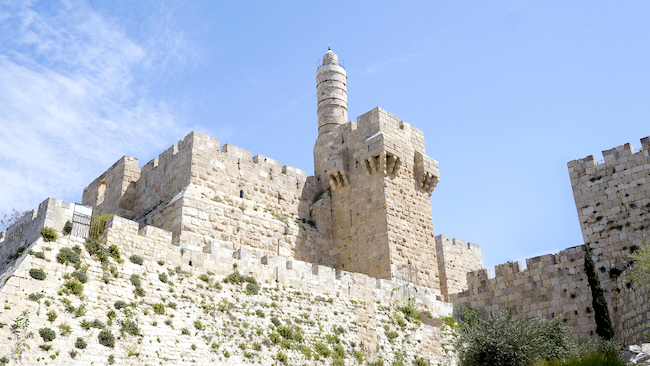
Radiating the World with the Light of Torah
This week’s Haftarah records Shlomo Hamelech’s production of the sacred vessels of the Bais Hamikdash. Our Haftarah seems to make a general summary of all of Shlomo’s work mentioned earlier in the chapter. The only apparent addition here is Shlomo’s production of three vessels that had served as integral parts of the Tabernacle in earlier years: the golden altar, the golden show- bread table, and the golden Temple Menorah.
Sanctuary’s Additional Vessels
However, a more careful reading reveals a significant dimension of the Bais Hamikdash that exceeds the requirements of the Tabernacle. We read in the last verses, “Shlomo constructed all the vessels for [their placement in] the house of Hashem: the
golden altar and the golden table upon which the show bread [was placed]. And [in addition he constructed] the refined golden Temple Menorahs [of which] five [were placed] to the right [of the main Temple Menorah] and five [were placed] to the left, in
front of the innermost chamber.” (48-49) We learn here that in addition to the three existing vessels from the Tabernacle, Shlomo produced ten Temple Menorahs to accompany the existing one. Since Chazal teach us that every detail of Shlomo’s elaborate Bais Hamikdash plan was prophetically ordained, (Sukka 51b) Hashem, apparently, altered His original plan from earlier times and required ten additional Temple
Menorahs for the Bais Hamikdash. It seems that although one Temple Menorah had sufficed for service in earlier times, the Bais Hamikdash service required ten more. Let us study this unique dimension of the Bais Hamikdash through the eyes of Chazal and discover some of its hidden value. We should note here that the ten Temple Menorahs were not the only vessels Shlomo added to the Bais Hamikdash. We read in Divrei Hayamim that he also added ten tables to accompany the existing table from earlier times. It states therein, “He produced the ten golden Temple Menorahs according to specification, and he placed them in the inner chamber five to the right and five to the
left. He produced ten [sacred] tables and placed them in the inner chamber, five to the right [of the main table] and five to the left [of it]…” It states afterwards, “Shlomo made all the [sacred] vessels for Hashem’s home. [He produced] the golden altar and the tables upon which the show bread was [placed]. He also produced the Temple Menorahs an their [oil] lamps in front of the dividing curtain.” (Divrei Hayamim II 4:7-8)
The Radiance of the Ten Menorahs
The blatant omission in our Haftarah portion of the additional tables that Shlomo produced, reflects that the additional Temple Menorahs mentioned here served a unique function in the Bais Hamikdash and were therefore highlighted in the production of its additional vessels. Let us attempt to uncover this hidden message through Chazal’s reflections on the additional vessels. They share with us the following points. The additional tables were designed to increase Hashem’s plentiful blessing to all growing crops. Since the Tabernacle was constructed to serve the Jewish people during their travel in the desert, there was little need for Hashem’s blessing for vegetation. Hashem provided their sustenance through the Heavenly manna bread that fell daily. However, once they peacefully settled in their homeland, Shlomo set up additional tables on the right to facilitate for blessed rain and dew to extend to the world, and tables on the left to repel all misfortune from befalling the Jewish people.
Chazal continue and explain that the ten Temple Menorahs represented the Ten Commandments. Chazal total the number of candles of the additional Temple Menorahs [each containing seven shafts] and conclude that the seventy additional oil lamps corresponded to the seventy nations of the world. They explain that in the merit of kindling seventy lamps, the corresponding world nations were subdued and held in
check throughout the years of the kindled lamps. They conclude and say that the Torah is likened to the light of a lamp, as Shlomo Hamelech says, “For the mitzvah is [likened to] a lamp and the Torah is [likened to] light.” (Mishlei 6:23, Yalkut Shimoni 185:4)
Temple Menorahs in Front of the Divider
Chazal’s cryptic concluding words suggest that the additional Temple Menorahs projected the Torah’s light to world nations, thereby subduing them. We can attempt to explain their message based on the following observation. We note that in the above segment from Divrei HaYamim, the positioning of the Temple Menorahs is repeated and even reworded. The verses initially state that Shlomo placed the tables and the Temple Menorahs in the inner chamber. It then repeats that Shlomo made the vessels and produced the tables and then concludes that he produced the Temple Menorahs to be placed in front of the (divider before) the innermost chamber. (translation based on Rashi
to Melachim I 6:20) Apparently because of the significance of that placement, the verse repeats the additional Temple Menorahs’ placement and connects it to the innermost chamber, in the context of being placed in front of its divider. In truth, the Torah refers to the placement of the original Temple Menorah in this same manner and states, “From outside the curtain of testimony in the inner chamber, Aharon
should arrange it [the wicks in the Temple Menorah] daily.” (Vayikra 24:3) Chazal deduce from the phrase “curtain of testimony” used there to define the position of the Temple Menorah, that the miraculous continuous burning of the western light in the Temple Menorah bore testimony to the world that the Divine Presence resides amongst the Jewish People in the Holy Ark behind the curtain. (Shabbos 21b) Maharal explains this statement to mean that the continuous radiance of that lamp beyond the natural capacity of its fuel source reflected that its radiance stemmed from a radiance behind the curtain or divider that transcended physical boundaries, namely the radiance of Hashem’s Presence housed inside the Holy Ark that contained the stone tablets of the Ten Commandments. (Gur Aryeh to Vayikra 24:3)
Outward Projection of Innermost Sanctity
The renowned Gaon, Harav Moshe Shapiro clarifies this point and explained that the miraculous radiance of the Temple Menorah projected the intense sanctity of Hashem’s presence behind the divider that was then translated into the radiance of Torah emanating from the Ten Commandments and projected through the radiance of the Temple Menorah to the Jewish People. The sanctity of its radiance inspired them to reflect on Hashem’s Presence in His innermost chamber by increasing their devout service to Him. (Afikei Mayim19) We can explain accordingly that Chazal deduced from the repetitive description in Divrei Hayamim of the additional Temple Menorahs placed in front of the “divider” a similar lesson, namely, that the additional Temple Menorahs illuminated world nations through the light that emanated from the Ten Commandments to the Jewish People through the radiance of the Temple Menorahs. For this reason, our Haftarah focused on
this specific dimension, and exclusively recounted the production of the additional Temple Menorahs. However, one point remains unclear. Although we mentioned earlier that Chazal link the production of the additional tables to a need that arose during Shlomo’s peaceful
times, they do not explain the timely production of the additional Temple Menorahs. Since the sacred tablets that contained the Ten Commandments were placed in the Holy Ark from the time of the Tabernacle’s construction, why did one Temple Menorah suffice
to radiate the Torah’s light during the times of the Tabernacle until the days of the Bais Hamikdash, but afterwards ten additional Temple Menorahs were required to radiate that Torah light?
The Timeliness of the Additional Candelabras
We can offer the following explanation for the Menorahs’ timely addition and can uncover with this some of our Haftarah’s message. We begin with the relationship between the Ten Commandments and the Torah’s remaining 603 mitzvos. The Torah
records that Hashem said to Moshe Rabbeinu, “Ascend the mountain [and come] to Me and stay there and I will give you the stone tablets and the Torah and the mitzvah that I wrote [on them] to teach the Jewish people.” Rashi explains that all 613 mitzvos are contained within the words of the Ten Commandments, and he refers us to Rabbeinu Sadya Gaon’s comprehensive listing of the mitzvos and their respective
commandments. (Shemos 24:12, Rashi ibid)
In view of this, we can suggest that the ten additional Temple Menorahs represented the ten root sources of all mitzvos, each Temple Menorah radiating the light of one of the Ten Commandments and its respective mitzvos. As we learned above, the radiance of the Ten Commandments was translated into the radiance of the Temple Menorah and was reflected to the entire world through the Jewish people’s increased devoted service to Hashem. Chazal therefore state that in the merit of kindling seventy lamps, the corresponding world nations were subdued and held in check throughout the years of their kindling.
Projected Radiance Through Mitzva Performance
To appreciate this message, we refer to the Torah’s warning regarding accurate mitzvah observance. The Torah quotes Moshe Rabbeinu who stated, “Behold I taught you statutes and principles …guard them and fulfill it [the Torah], for it is [your display of] knowledge and wisdom in the eyes of world nations who, after learning of your statutes, will say, ‘what a wise understanding people is this great nation’…for what great nation has just statutes and principles likened to the Torah…But greatly guard yourself…not to
forget [any of] these matters.” (Devarim 4:5-9) Rashi explains that Moshe warned the Jewish people that if they practice all Torah
principle as prescribed, then they will be regarded as wise and understanding in the eyes of world nations. But, if due to forgetfulness, they practice mitzvos in a perverted way, then they will be regarded as fools. Ramban adds that when statutes are accurately practiced, world nations will recognize the Divine wisdom and understanding of Hashem Who structured them. We now understand that the Temple Menorah’s radiance that reflected Hashem’s Presence in the innermost chamber inspired the Jewish people to meticulously practice
all Torah precepts that reflected the Divine source of their devout service. Once the Jewish people peacefully settled in Eretz Yisrael and had opportunity to accurately practice all 613 Torah precepts, they projected the radiance of Torah to world nations who, out of reverence and respect to those who reflected that radiance, were peaceful and subdued towards the Jewish People and even admired their greatness. This explains why, during Shlomo’s era, world nations and their leaders flocked to Yerushalayim and to Shlomo Hamelech to learn and absorb the Divine wisdom of Torah. In conclusion, we can explain why our haftarah reading records the completion of the Sanctuary vessel production with its additional Temple Menorahs. Since this week’s Parsha records the Jewish People’s production of the Tabernacle vessels, our Haftarah completes that production. In effect, it displays how Hashem’s Presence that resided in the Bais Hamikdash served its fullest purpose through the radiance of all Torah precepts to the Jewish People and from there to all world nations. Although we don’t have the merit to house Hashem’s Presence in our midst, we do possess His Torah that reflects Divine wisdom and understanding that should produce reverence and admiration. Let it be Hashem’s will that all His children properly observe His precepts, thereby projecting His radiance throughout the world and lighting the way for all world nations to follow.


